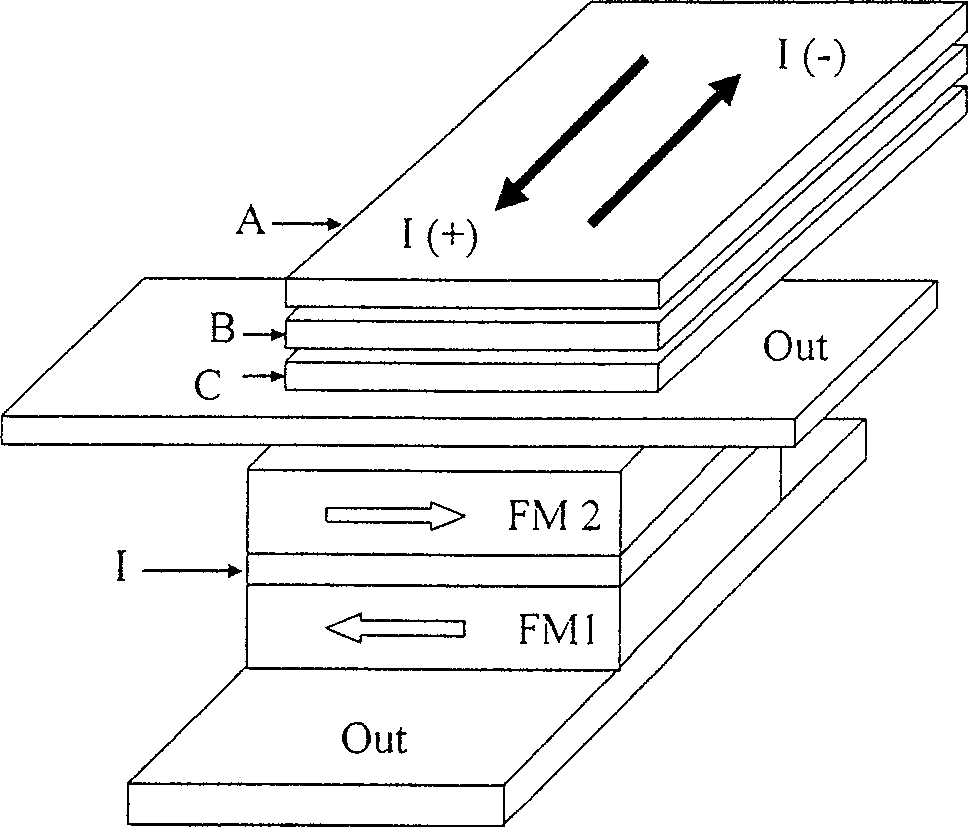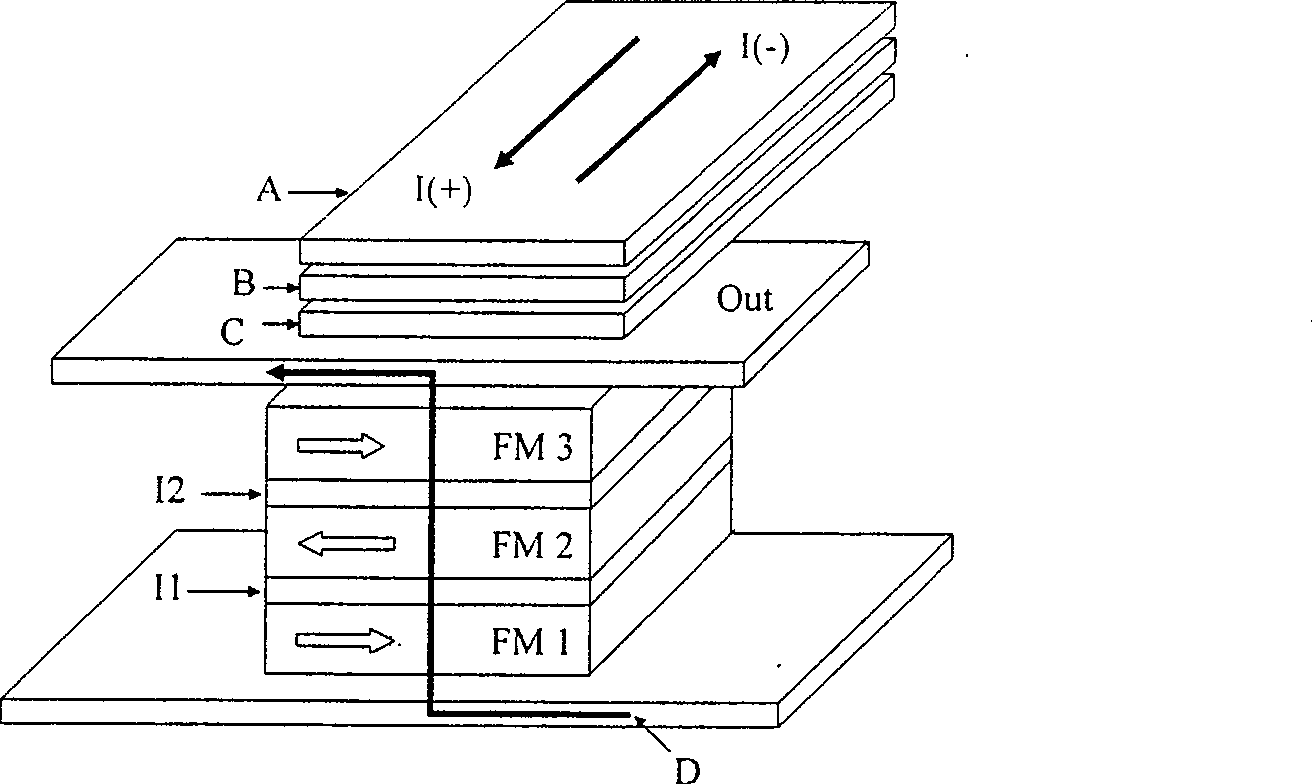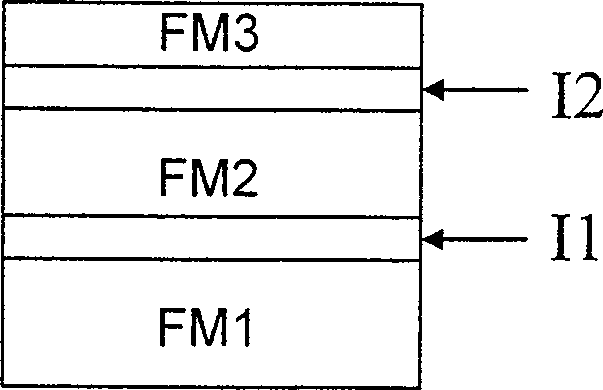Logic part and magnetic logic part array based on the dual potential base magnetic tunnel junction
A magnetic tunnel junction and logic element technology, applied in the field of magnetic logic, can solve the problems of unfavorable miniaturization and integration of magnetic logic
- Summary
- Abstract
- Description
- Claims
- Application Information
AI Technical Summary
Problems solved by technology
Method used
Image
Examples
Embodiment 1
[0041] Such as image 3As shown, the first magnetic logic element core structure based on the double-barrier magnetic tunnel junction provided by the present invention includes the following five layers: three layers of ferromagnetic layers FM1, FM2 and FM3, and two tunnels in the middle of the three layers of ferromagnetic layers Barrier layers I1 and I2. The magnetic layers FM1 and FM3 are composed of "hard magnetic layer" CoFe with a large coercive force, and its thickness is 3nm. The magnetic layer FM2 is composed of a "soft magnetic layer" NiFe with a small coercive force of 10nm; the tunnel barrier layer is composed of 1.0nm Al 2 o 3 constitute.
[0042] Since the material composition and thickness of the magnetic layers FM1 and FM3 are the same, the switching fields of the two layers are the same, and the magnetization state of the double-barrier tunnel junction at this time is similar to that of the single-barrier tunnel junction. In this scheme, the input lines A,...
Embodiment 2
[0050] Such as Figure 4 As shown, the second magnetic logic element core structure based on the double-barrier magnetic tunnel junction provided by the present invention includes the following five layers: three layers of ferromagnetic layers FM1, FM2 and FM3, and sandwiching two tunnels in the middle of the three layers of ferromagnetic layers Barrier layers I1 and I2. The magnetic layers FM1, FM2 and FM3 are made of 4nm CoFeSiB soft magnetic material with high spin polarizability. Among them, FM1 and FM3 are pinned by 12nm antiferromagnetic material IrMn, so that the magnetization direction of the two layers is relatively fixed, while the magnetization direction of FM2 can be reversed in a small magnetic field, which is the free layer. Tunnel barriers I1 and I2 are made of AlN with a thickness of 0.8nm.
[0051] The operation mode of the magnetic logic element based on this structure is similar to Embodiment 1.
Embodiment 3
[0053] Such as Figure 5 As shown, the core structure of the third magnetic logic element based on the double-barrier magnetic tunnel junction provided by the present invention includes: a lower antiferromagnetic layer AFM1; a lower magnetic layer composed of FM11 / Ru / FM1 artificial antiferromagnetic coupling structure layer; an upper magnetic layer composed of FM3 / Ru / FM31 artificial antiferromagnetic coupling structure; and two tunnel barrier layers I1 and I2 sandwiched between three ferromagnetic layers (FM1, FM2, FM3); an upper antiferromagnetic layer Magnetic layer AFM2. FM1, FM2 and FM3 are composed of 4nm CoFeB soft magnetic material with high spin polarizability, FM11 and FM31 are composed of 2nm CoFe material, and the thickness of Ru is 0.8nm. Among them, FM1 and FM3 are artificially antiferromagnetically pinned by antiferromagnetic materials PtMn and CoFe(2nm) / Ru(0.8nm) / CoFeB(4nm), the magnetization direction of these two layers is relatively fixed, while the magnetiz...
PUM
 Login to View More
Login to View More Abstract
Description
Claims
Application Information
 Login to View More
Login to View More - R&D
- Intellectual Property
- Life Sciences
- Materials
- Tech Scout
- Unparalleled Data Quality
- Higher Quality Content
- 60% Fewer Hallucinations
Browse by: Latest US Patents, China's latest patents, Technical Efficacy Thesaurus, Application Domain, Technology Topic, Popular Technical Reports.
© 2025 PatSnap. All rights reserved.Legal|Privacy policy|Modern Slavery Act Transparency Statement|Sitemap|About US| Contact US: help@patsnap.com



